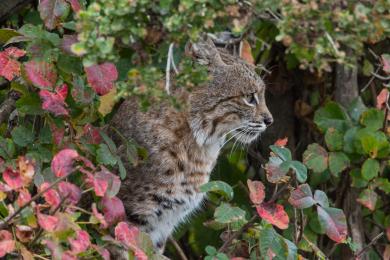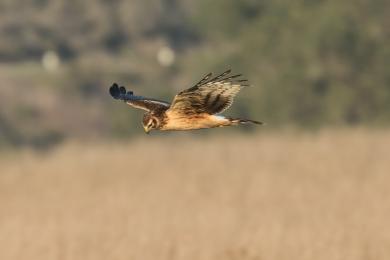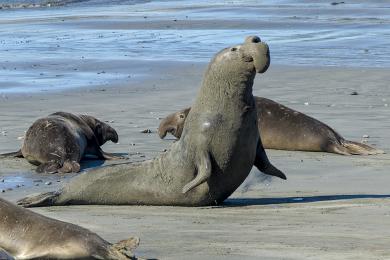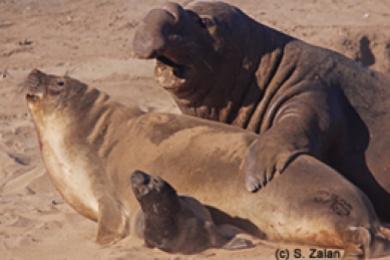There is much to see at Año Nuevo in addition to the elephant seals. The buildings are part of a post-civil-war era dairy, as evidenced by the low ceilings in the former dairy-barn that serves as the visitor center and also houses our park store. The horse barn, where refreshments will be offered, is where you can meet the researchers – both UC Santa Cruz for marine mammals and Oikonos who help restore habitat for nesting sea birds found on Año Nuevo Island. We recommend that you arrive early for the afternoon session or plan on staying a bit longer after the morning session to take in the history of the park.
A number of other animals also call Año Nuevo home: bobcats, coyotes, mule deer and many smaller mammals, and numerous birds such as this northern harrier in the photo to the right. We hope you see something interesting during the walk from the barns to the wildlife reserve.
The extended viewing of the elephant seals during Seal Adventures lends itself to both observation and photography. If you are an avid photographer, you may wish to carry a tripod to stabilize your camera and lens, but please remember you will be walking about four miles. The advantage of this event over a normal guided walk is that you can stay in one spot for an extended time, conditional upon your safety and the 25 feet distance we must allow between ourselves and the seals.
As with all images, the subject matter is most important. Unfortunately, with elephant seals, if there is no activity then the images are not appealing. It is all too easy to get photos that make you wonder why you took so many pictures of boulders.
Of course action photos with elephant seals take some time, so be patient but also know your subjects. The seals are most active in the cooler parts of the day. Early morning and late afternoon are reliably more active times for the seals than mid-day, especially when it is hot and sunny. Most of the activity from the males at this time of year will occur when challenges for dominance take place. Watch for bulls sneaking into the harem as it will always elicit a response.
Everyone wants to see a birth but recording it can be difficult; even many of our docents haven’t seen one. The pregnant female can be identified by the rounded back and absence of a pup (such as behind the mother in the second image below). She usually gives birth within three to five days of arriving. Also observe the birds; the ravens and gulls are often the first sign a birth is imminent (or has happened). The birth process goes fast and ends with the mother turning around to vocalize to her pup. This vocalization forms a bond that will last for the next four weeks until the pup is weaned.
On the other hand, the mating process is easily observed. The male will sidle up next to the female and place his flipper over her back, a position known to the docents as “FOB”. The female will protest to ensure that she is mating with the dominant male. If the suitor isn’t the dominant male in the harem, and the alpha bull isn’t otherwise engaged, there will be a challenge.
One last consideration for the day is weather protection. If the conditions are wet, come prepared to be able to walk to the Point and enjoy the viewing. Seal Adventures will be held rain or shine and seal activity is often increased during rainy weather.
Whatever your interests, make sure you enjoy yourself. Sometimes it is worth putting the cameras down and enjoying the amazing sights of the natural wonders that surround us.

Tickets sell out in advance of the event, so if you want to join us next year please don’t wait when tickets become available.





